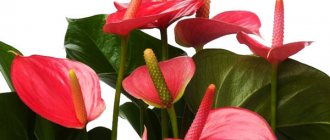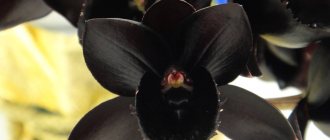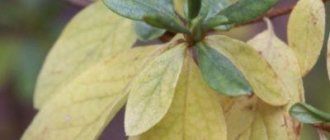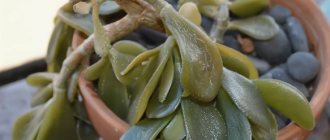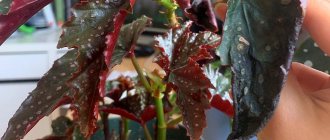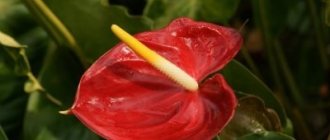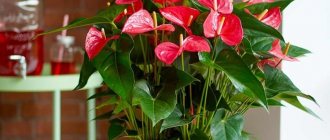Anthurium is an overseas guest on our windowsills. Many amateur flower growers know it as “male happiness” and “flamingo flower.” It pleases with its long flowering regardless of the time of year. Bright waxy flowers, as if made of paraffin, attract attention. In our country, the most common anthurium is the one with the red flower. But, besides it, there is also purple, and white, and pink.
An inexperienced gardener may think that anthurium does not require care. But, by its nature of origin, it is accustomed to a warm climate, fairly bright but not scorching color, light soils and fairly humid air. Anthurium quickly adapts to the conditions of its new home, gives good growth and blooms. But, out of the blue, it suddenly starts to hurt. Most likely, this is due to stress from new conditions. Therefore, the first way to prevent diseases is to strictly adhere to agricultural techniques for growing anthurium.
Most often, the leaves of the flower suffer from various diseases. We will consider further what diseases of anthurium can manifest themselves, what they look like in the photo and how to treat them.
Anthurium diseases can be divided into three root causes:
- Failure to comply with agricultural cultivation techniques.
- Infectious diseases.
- Insect pest damage.
Anthurium leaves turn yellow
If you want to have a beautiful, healthy flower with bright and lush blooms on your windowsill, provide it with the necessary care. Violation of agricultural cultivation techniques is one of the most common causes of yellowing of anthurium leaves. Despite other factors, it is the maintenance in the wrong conditions that weakens the strength of the plant. Let's take a closer look at the different types of anthurium leaf diseases and their photos, as well as ways to solve problems :
- Yellowing of the lower leaves. This indicates the aging of the plant. It is necessary to remove the yellowed leaf with a sharp knife. Do the same with subsequent leaves; your plant needs rejuvenation.
- Yellowing of the leaves of a young plant, as well as dark spots, can be the result of sunburn. Although Anthurium is a light-loving plant, it still needs to be shaded from direct sunlight. This flower prefers diffused lighting.
- Fading color of leaves. In this case, the leaves do not turn yellow, but lose their rich, bright green color. In this case, unlike the previous problem, the flower does not have enough light. Perhaps he is standing in a dark place. Then it is necessary to additionally highlight it or move it to a more illuminated place.
- Dark spots on anthurium leaves. Such damage to the leaves indicates that the plant is cold in the conditions where you placed it. The optimal temperature for growing a flower is 18-24°C.
- Young leaves are unusually large and do not have a rich green color. This suggests that the grower overdid it with the amount and frequency of fertilizing. It is necessary to temporarily stop feeding the anthurium and watering it to wash away excess fertilizer. If, on the contrary, you did not fertilize the flower, but there is a problem, then it’s time to add a dose of microelements.
- The tips of the leaves dry out throughout the plant, and sometimes the entire leaf turns black. There may be several reasons: insufficient air humidity, they forgot to water the plant, the roots became too crowded in the pot, too much calcium in the soil.
- Anthurium leaves lose turgor Turgor is a tense state of the membranes of living cells, including leaves. The cells are filled with water and the membranes become stretched and remain in a tense state. Turgor is taken out, but does not fall off. This happens due to waterlogging of the soil. If everything is fine with watering, the root may be infected with rot.
- Dots on leaves. The reason is watering with hard water. Use only soft, settled or melt water for irrigation.
The florist may encounter two more manifestations of incorrect agricultural cultivation techniques. Anthurium may not grow or bloom, may be pale and generally be in a sluggish, depressed state. This indicates insufficient nutrition of the flower. The soil in which it is now planted is too poor in the necessary nutritional components. And if the flower turns black and dries, its natural flowering period may have expired, or the plant may have been exposed to direct sunlight. Often the inflorescence may turn black due to moisture that accidentally fell on it during spraying. Do not forget that the affected leaves or bud must be removed.
Plant care rules
Anthurium is a capricious plant. Some of its species are grown only in greenhouse conditions. It is also important to take into account when growing a plant that its juice consists of toxins that can adversely affect human mucous membranes.
Features of caring for anthurium:
- It is recommended to grow the flower in partial shade or on a windowsill with diffused light, as it does not like bright light. At the same time, it is important to provide the anthurium with additional lighting in winter. Otherwise, the plant will not produce flower stalks.
- In summer, the air temperature in the room should not exceed 25 degrees Celsius, and in winter the plant can develop at a temperature of 14 - 16 degrees.
- To prevent the anthurium from dying, it is necessary to avoid places with drafts.
- It is recommended to water the flower with slightly warm water. In summer, watering is carried out once every three days, and in winter - once every seven days. The remaining water from the pan after watering must be poured out so that the roots do not rot.
- It is also important to ensure good air humidity in the room where the flower is grown. Spray the leaves systematically, but in such a way that water does not get on the flowers.
- Twice a month, feed the anthurium with a mineral solution or organic fertilizer. It is necessary to feed during flowering and active growth of the plant.
- Anthurium grows best in self-prepared soil. Mix humus (two parts) with leaf soil and peat (one part each), as well as sand (half part). Crushed bricks or cones are added as drainage.
- After purchasing an anthurium, it is important to transplant it into a new, suitable-sized pot with the correct soil.
Anthracosis and powdery mildew
Anthracosis or powdery mildew (whether downy or real) can affect anthurium. The causative agents of diseases are fungi that develop rapidly. And if you do not act immediately, the plant may die. When an anthurium leaf is affected by anthracosis disease, dried brown spots with dark dots appear on it. These are fungal spores. Anthracosis progresses in warm and humid conditions. Just the kind that anthurium needs.
When an anthurium leaf is infected with powdery mildew, spots with a white coating appear first on the back side and then on the outside.
They may have the appearance of white-gray pubescence. The plant has a sickly, weakened appearance. Causes of the disease :
- increased air humidity;
- violation of the temperature regime of the flower;
- sudden temperature changes.
Both diseases of anthurium leaves, anthracosis and powdery mildew, develop very quickly and require an immediate response from the grower. It is necessary to immediately separate the diseased plant from other flowers to protect them. Remove any affected leaves. It is necessary to burn them. Next comes the treatment of the leaf with special chemical fungicides, for example, Abiga-Pik, Fitosporin, Acrobat, etc. Wipe the leaves with a 1% solution of Bordeaux mixture. Feed the plant with phosphorus-potassium fertilizer.
It is advisable to minimize watering and spraying during the treatment of anthurium. If most of the flower plant is already affected, the soil and pot must be destroyed. This is the only way you can protect the rest of the flowers in your home.
Appearance of brown spots
The cause of this problem may be too low an air temperature or improper application of fertilizers. How many degrees should the room be? At least 22C. Therefore, to eliminate the problem, you can additionally install heating. And for feeding, use only specially selected formulations that take into account the balance of essential nutrients, vitamins and microelements.
Another cause of brown leaves can be mealybug activity. To eliminate the pest, it is recommended to use insecticidal preparations (Karbofos).
With the right approach to cultivation, multiple problems with anthurium can be avoided.
Video anthurium disease prevention
Rust
A disease of anthurium leaves, such as rust, appears as a result of damage to the plant by rust fungi. They remain viable on the affected leaf. Rust affects not only the leaf itself, but also the stem of the anthurium. Brownish-rusty thickening spots appear on them, like pads. Small spots soon merge, affecting the entire leaf, which soon dries out. A diseased anthurium may bend to one side due to damage to the stem. An infected flower not only loses its decorative effect, but may even die. Because the fungus reduces his vitality. Causes of anthurium leaf disease :
- transfer of fungus from other plants;
- keeping anthurium in too dry conditions;
- too frequent and abundant spraying;
- keeping in an unventilated area.
Leaves with large areas of rust should be removed and burned. The remaining leaves are treated with fungicidal preparations. Bordeaux mixture is suitable both for the treatment of rust and for the prevention of diseases of anthurium leaves. During the treatment period, it is advisable to separate the anthurium from other indoor flowers to avoid infection.
Non-communicable diseases
The appearance of diseases is promoted by improper care of plants. Non-infectious diseases include smallpox, chlorosis, enation.
Plant pox
When a disease is caused by errors in care, various raised spots appear on the leaves. They can be yellow or yellowish-green in color. Such deformity of leaf plates can occur when the air humidity does not match the temperature.
On a note! We must not forget about timely feeding of anthuriums. After all, healthy specimens are less susceptible to diseases.
Chlorosis
The disease occurs as a result of a deficiency of two important elements - iron and magnesium. Their deficiency manifests itself in yellowing of the foliage or the appearance of yellow stains on the leaf blades.
Enatsii
The disease can be recognized by its ugly leaves. The first sign is that the foliage began to grow unevenly, the plates themselves become convex and humpbacked. Incorrect temperature contributes to the appearance of enation. The room may be too stuffy, too cold, dry or humid. Getting rid of the problem will help by establishing proper care for the plant and following agrotechnical growing practices.
Anthurium disease - Septoria
Septoria is a fungus that can infect anthurium leaves during contact with contaminated soil or air currents in which there were spores. The disease develops in warm and humid conditions. Dry brown spots with a characteristic yellow border appear on a diseased anthurium leaf. Gradually, the diseased leaf dries out completely, and the spores move to the healthy leaf. Causes of the disease : • infection after purchasing new plants; • non-compliance with the rules during flower transplantation; • abundant watering after drying out the earthen clod. Septoria fungus spores are resistant to high temperatures and some chemicals. This makes treatment and prevention difficult. To treat septoria in anthurium, remove the affected leaf and treat the plant with fungicides that contain copper. The soil also needs to be treated. For this you can use Abiga-Peak, Acrobat, Vitaros, Fundazol.
Darkening of green mass
If the leaves begin to darken, while the roots also suffer, and the stem section is limp, this may indicate the presence of an increased concentration of a microelement such as calcium in the soil substrate. An excellent solution to the problem is to transplant the flower into a higher quality soil mixture with a balanced composition, selected specifically for epiphytes (for example, soil substrate for orchids).
Fertilizer application must also be done correctly. It is not recommended to feed the soil too often; this can damage both roots and leaves.
Fusarium wilt
Fusarium wilt is an infectious disease that can affect not only anthurium, but also many other indoor plants. It affects the root system, trunk and leaves of the flower. Characterized by unexpected and rapid withering of the entire plant. You can see a pale pink coating on the root collar. The disease develops rapidly in warm and humid conditions. So watering the flower will only accelerate the development of the disease.
Anthurium disease Fusarium wilt can be recognized at an early stage. If the gardener notices bending of flower stalks and yellowing of leaves. It is possible to overcome an infection only at the very beginning of its development. The anthurium bush needs to be removed from the pot, the roots should be thoroughly washed under running water, then soaked in a solution of foundationazole. Afterwards, trim off all affected and unhealthy areas on it. Then transplant the flower into fresh soil and a new pot. The bush is treated with copper-containing preparations.
Viral diseases
Among the viruses that affect anthurium is the bronze virus.
Bronzing virus
An unpleasant disease that manifests itself as discoloration of plant foliage. With the armed eye, you can notice pronounced wrinkles and small through dots on the surface of the sheet.
The virus is spread by insects, such as thrips. The disease cannot be treated; it cannot be cured. The diseased specimen will have to be thrown away. And other indoor plants need to be inspected for the presence of thrips so that they cannot spread the bronzing virus. For processing, you can use Actellik or Aktar.
Insect pests
Not a single flower is immune from damage to a flower by various pests. Even those in the cultivation of which all agrotechnical rules are observed. Parasites can infect the peduncle itself. The peduncle is the upper part of the stem on which the inflorescence grows. At the initial stages of development in orchids, it is difficult to distinguish the peduncle from the root. Here are some differences: •, leaf, stems and roots. Anthurium is quite resistant to attack by insect pests. However, sometimes he can become their victim. Such attacks weaken the vitality of the plant, sucking the juices out of it. Who affects anthurium and how to deal with insect pests:
- Aphids - feed on the juice from the anthurium, sucking it out. The affected bush withers, the leaves curl and a sticky coating appears on them. If the gardener notices the pest at an early stage, it will be enough to bathe the anthurium under a warm shower with laundry soap. If the flower is severely affected, treatment with insecticides is necessary. Aktara and Antitlin will do.
- Thrips - settle on the back of the leaves, leaving behind black dots there. Yellow spots of different sizes appear on the bush. Thrips can appear at any time of the year, but the spring and summer period is the peak of their development. Sick anthurium is sprayed with insecticides. For example, Tantrek, Acttelikt. The treatment procedure must be repeated every three to four days until the insects completely disappear.
- Scale insects - at the initial stage of the appearance of this pest it is not visible. This makes it much more difficult to fight him. Scale insects are glued to the leaf. They must be removed mechanically. That is, with a cotton swab or needle. Scale insects have a very dense shell, so treatment with chemical insecticides does not give the desired result. Oil solutions and kerosene can help remove scale insects. After them, you need to wash the anthurium with a solution of laundry soap.
- Spider mite - when it infects anthurium. Small yellow spots appear on it. The spots spread quickly and the leaf wilts. It is impossible to see a tick with the naked eye. But the cobweb is visible. It wraps the leaf, stems and flower. Why do they curl and wither? On the affected anthurium, you need to remove the cobwebs. After which the flower, pot and the nearest surface are washed with soapy water. If the plant is heavily infected, it is necessary to treat it with insecticides. If you do not care for the plant correctly, the spider mite may return.
Do not forget that during the treatment period it is necessary to isolate the diseased anthurium bush from other indoor flowers.
When treating and preventing diseases in indoor flowers, it is advisable to use biofungicides. They are safe for humans and animals. Still, it is better to prevent anthurium disease than to treat it. Follow agricultural cultivation techniques, regularly inspect the flower for the presence of fungi and pests, pay attention to any changes in the color saturation of the leaves. In a healthy anthurium they are dense and bright green. It is advisable to carry out preventive measures 1-2 times a month. This way you will protect your plants from diseases, and yourself from unnecessary hassle, and you will get beautiful flowering plants that breathe life and beauty.
Infectious diseases
Among the diseases spread by infectious means are septoria and fusarium wilt. If the disease is detected too late, it is practically impossible to cure.
Septoria
The presence of the disease is indicated by brown spots on the leaves of plants. They usually have an irregular shape, with a brown or yellow border around the edges. If you look at the spots through a magnifying glass, in the middle of them you can see small black dots - sporangia.
How to treat anthurium leaves from septoria?
If septoria is severely affected, all the foliage will have to be torn off and burned. The air humidity in the room should be reduced. It is recommended to exclude plant care procedures such as spraying foliage.
The flower needs to be fed with complex fertilizers for flowering plants. After inspection for pests, the anthurium must be treated with copper-containing preparations or sprayed with Fitosporin-M.
Fusarium wilt
A rather serious disease in which the foliage withers massively. First it turns yellow, then it dries out and falls off. If you examine the root collar, you will notice a white-pink coating. The infectious disease spreads during watering, when the optimal air humidity does not correspond to the temperature.
Attention! So far, no effective method has been discovered to combat Fusarium wilt. You can try spraying the green mass of the plant with fungicides and spraying the soil with pesticides. To save the plant, it is important to try all methods of control.
Treatment should be carried out three times at weekly intervals. A single treatment has never brought a positive result.
Rust
When the disease occurs, irregularly shaped spots colored light yellow can be seen on the upper part of the leaf blade, and brown spots and pustules can be seen on the underside of the leaf. As the disease develops, the spots spread throughout the entire leaf, the plate withers and dries out. Treatment is carried out using fungicides.
Powdery mildew
It would seem that the plant likes everything, it smells fragrant and pleases the eye, and suddenly an incomprehensible leaf fall begins. What is the reason why the plant’s leaves began to turn yellow and dry? Powdery mildew damage is indicated by a white coating that spreads throughout the entire green mass of the plant. Treatment with Topaz gives good results.
